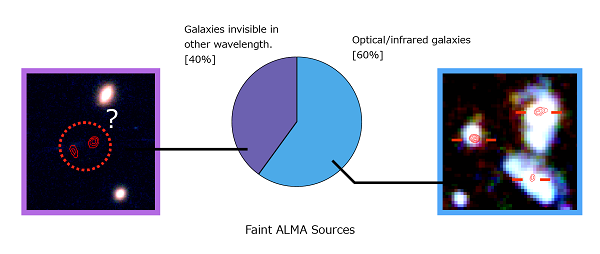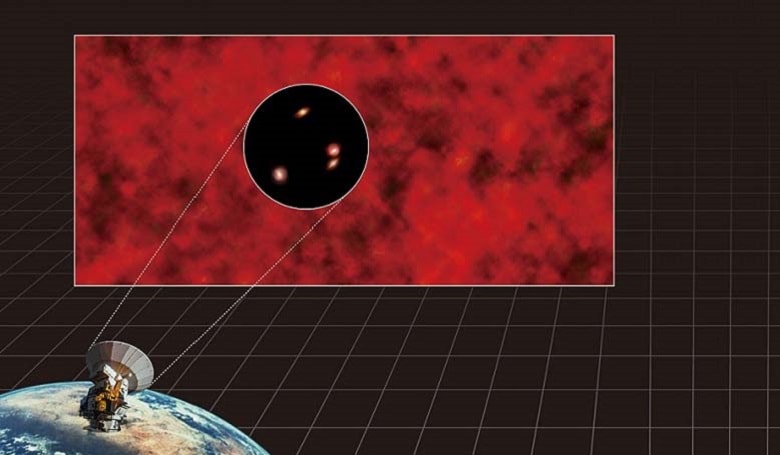The origin of faint but uniform millimetre-wave light, that pervades the Universe and is called the “cosmic infrared background emission,” has finally been resolved by astronomers using the Atacama Large Millimeter/submillimeter Array (ALMA). By searching through data accumulated with ALMA taken over 900 days, the research team led by a graduate student, Seiji Fujimoto and an associate professor, Masami Ouchi, at the University of Tokyo have revealed that 60% of the objects they studied in order to determine the source of this enigmatic light is mostly emitted from faint galaxies, whereas the rest have no corresponding objects in optical/infrared wavelengths and their nature is still unknown.
Along with the well known Cosmic Microwave Background (CMB), two other forms of radiation, the Cosmic Optical Background (COB) and the Cosmic Infrared Background (CIB) are types of emission that are ubiquitous in the Universe. The CMB is the well known radiation left over from the big bang and the COB has been revealed to be light from a huge number of stars. Until now, it was only the CIB that was left unaccounted for.
“The origin of the CIB is a long-standing missing piece in the energy coming from the Universe,” said Fujimoto, now studying at the Institute of Cosmic Ray Research, the University of Tokyo. “We devoted ourselves to analyzing the gigantic ALMA data in order to find the missing piece.”
ALMA is the perfect tool to investigate the source of the CIB, thanks to its unprecedented sensitivity and resolution and as the CIB emission in millimeter and submillimeter waves does not become weak even if the source is located far away, this wavelength (around 1mm) is suitable for looking through the Universe to the most distant parts. Indeed, as part of the study, the team discovered 133 faint objects, including an object five times fainter than any other ever detected. By summing up the emissions from such objects, Fujimoto and team found that the entire CIB can be explained with their analysis.

This is not the first time that the origin of the CIB has been searched for. Various research projects, including past ALMA observations, have been conducted, but they could only explain half of the CIB. Now however, ALMA has accumulated a vast data archive and along with extensive searches through datasets of lensed sources, where huge gravity has magnified the source making even fainter objects visible, the team were able to identify the source of this omnipresent infrared glow. Well, most of it.
Dust in galaxies absorbs optical and infrared light and re-emits the energy in longer millimeter waves which can be detected with ALMA. By comparing the ALMA data with the data taken by the Hubble Space Telescope and the Subaru Telescope, the team found that 60% of the objects they studied are galaxies which can also be seen in the optical/infrared images. But what about the other 40% then?
“We have no idea what the rest of them are,” explains Ouchi. “I speculate that they are galaxies obscured by dust. Considering their darkness, they would be very low-mass galaxies. This means that such small galaxies contain great amounts of dust. That conflicts with our current understanding: small galaxies should contain small amounts of dust. Our results might indicate the existence of many unexpected objects in the distant Universe. We are eager to unmask these new enigmatic sources with future ALMA observations.”











